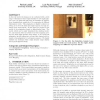Free Online Productivity Tools
i2Speak
i2Symbol
i2OCR
iTex2Img
iWeb2Print
iWeb2Shot
i2Type
iPdf2Split
iPdf2Merge
i2Bopomofo
i2Arabic
i2Style
i2Image
i2PDF
iLatex2Rtf
Sci2ools
AFRIGRAPH
2004
ACM
2004
ACM
A local model of eye adaptation for high dynamic range images
In the real world, the human eye is confronted with a wide range of luminances from bright sunshine to low night light. Our eyes cope with this vast range of intensities by adaptation; changing their sensitivity to be responsive at different illumination levels. This adaptation is highly localized, allowing us to see both dark and bright regions of a high dynamic range environment. In this paper we present a new model of eye adaptation based on physiological data. The model, which can be easily integrated into existing renderers, can function either as a static local tone mapping operator for single high dynamic range image, or as a temporal adaptation model taking into account time elapsed and intensity of preadaptation for a dynamic sequence. We finally validate our technique with a high dynamic range display and a psychophysical study. Categories and Subject Descriptors I.3.3 [Computer Graphics]: Picture/Image Generation— Display Algorithms Keywords Human Visual System, Eye Ada...
| Added | 30 Jun 2010 |
| Updated | 30 Jun 2010 |
| Type | Conference |
| Year | 2004 |
| Where | AFRIGRAPH |
| Authors | Patrick Ledda, Luís Paulo Santos, Alan Chalmers |
Comments (0)

